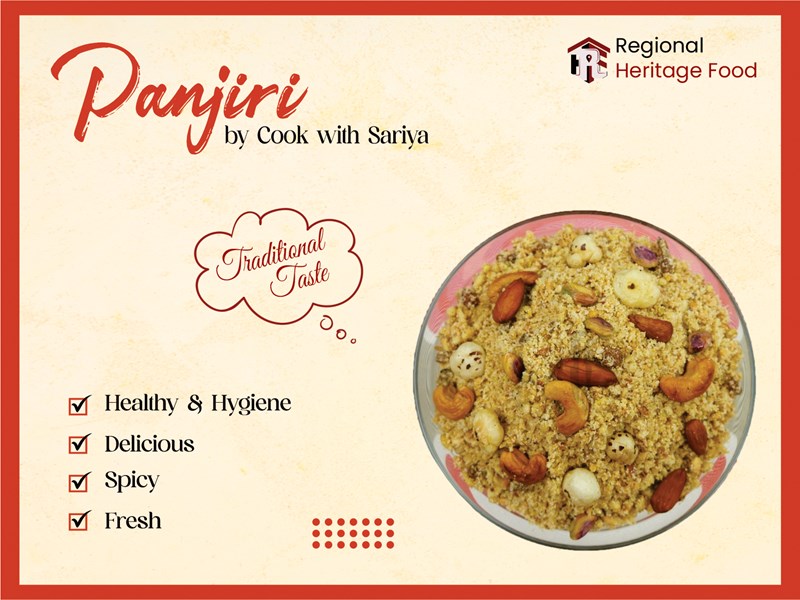Traditional Panjiri Recipe by Cook with Sariya | Nourishing Indian Sweet | RHF (Recipe)

Learn how to make Panjiri, a traditional Indian sweet dish, with this simple recipe by Cook with Sariya. Packed with nourishing ingredients like ghee, nuts, and semolina, this delightful treat is perfect for festivals and winter months. Store in an airtight container for up to 3 months.
Panjiri Recipe | Traditional Indian Sweet | Cook with Sariya
Introduction
Panjiri is a cherished traditional sweet dish in Indian cuisine, known for its rich flavor and nourishing ingredients. Often made during festivals and winter months, this delicious treat is packed with the goodness of roasted sariya (vermicelli), wheat flour, jaggery, and an assortment of nuts such as almonds, cashews, and pistachios. Flavored with cardamom and fennel seeds, Panjiri is not only indulgent but also wholesome, making it a popular choice for all age groups. Here's how you can make this delightful dish at home with Cook with Sariya's easy-to-follow recipe.
Improved Recipe
Ingredients
- Pure Organic Ghee: 2-3 tablespoons (or as required)
- Gondh (Edible Gum Crystals): 100 grams
- Makhanay (Puffed Lotus Seed): 100 grams
- Kaju (Cashew Nuts): 100 grams
- Badam (Almonds): 100 grams
- Pista (Pistachios): 100 grams
- Asli Desi Ghee (Pure Organic Ghee): 1 cup (or as required)
- Jaggery: 250 grams
- Sooji (Semolina): 3-4 tablespoons
- Whole Wheat Flour: 1 cup
Method
1. Fry the Gondh:
- In a wok, heat 2-3 tablespoons of pure organic ghee. Add 100 grams of Gondh (edible gum crystals) and fry them until they puff up and double in size. Once done, remove from the wok and set aside.
2. Fry the Makhanay:
- In the same wok, add the puffed lotus seeds (Makhanay) and fry until they turn light golden. Remove from the wok and set aside.
3. Fry the Nuts:
- Add the cashew nuts to the wok and fry until golden brown. Follow by frying the almonds and pistachios separately until they release their aroma and are slightly browned. Set all the fried nuts aside.
4. Chop the Fried Ingredients:
- Using a food chopper, coarsely chop the fried Gondh, lotus seeds, cashew nuts, almonds, and pistachios. Set aside for later use.
5. Prepare the Jaggery Syrup:
- In a pot, add 1 cup of pure organic ghee and 250 grams of jaggery. Cook on low heat until the jaggery melts and reaches a thick syrup-like consistency. Remove from heat and set aside.
6. Cook the Semolina and Flour:
- In another pot, heat some more ghee and add 3-4 tablespoons of semolina (sooji). Roast it until it turns light golden brown. Then, add 1 cup of whole wheat flour and roast until the mixture turns aromatic and golden in color.
7. Combine All Ingredients:
- To the roasted semolina and flour mixture, add the jaggery syrup and mix thoroughly until it reaches a thick consistency. Then, add the chopped Gondh, lotus seeds, and fried nuts. Mix everything well to ensure an even distribution of ingredients.
8. Shape the Panjiri:
- Allow the mixture to cool slightly before shaping it into small round balls or storing it as loose Panjiri. Ensure to press the mixture firmly when shaping the balls.
9. Storage:
- Store the Panjiri in an airtight container. It can be kept for up to 2-3 months, making it a perfect snack to have on hand during the colder months.
Calories Information
- Calories per serving (approximately 50g): 150-200 kcal
Health Benefits and Precautions
Health Benefits:
- Energy Booster: Panjiri is rich in healthy fats and protein, making it an excellent energy booster, especially during the winter months.
- Nutrient-Rich: Packed with nuts and ghee, Panjiri provides essential vitamins and minerals like Vitamin E, calcium, and magnesium.
Precautions:
- High in Calories: Due to its rich ingredients, Panjiri is high in calories and should be consumed in moderation, particularly by those monitoring their calorie intake.